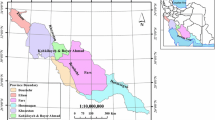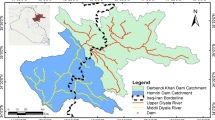Abstract
This study aims to contribute to water resource management in Mikkés watershed using the SWAT (Soil and Water Assessment Tool) model. This model requires several input data, such as rainfall, temperature, digital elevation model, soil characteristics, and land use. The outputs of the model are water balance and sediment yield at sub-basin. The SWAT model was run and calibrated using Sequential Uncertainty Fitting (SUFI-2) method in SWAT–CUP software for the period 1979–2007 with an efficiency of adjusted model rated as good (NSE = 0.67, PBIAIS = 6.78, RSR = 0.56). The balance of water generated by the model shows a dominance of evapotranspiration which represents 65% of rainfall, while surface runoff is 15% and total aquifer recharge is 20%. The model indicates that the sediment yields are largest in the southern area of the basin resulting in high slope, high rainfall, land use and erodible soils. These results revealed that hydrologic model can be used efficiently to support integrated watershed management.










Similar content being viewed by others
References
Abbaspour K (2007) User Manual for SWAT-CUP, SWAT calibration and uncertainty analysis programs. Swiss Federal Institute of Aquatic Science and Technology, Eawag, Duebendorf, Switzerland
Abbaspour KC (2008) “SWAT-CUP2: SWAT calibration and uncertainty programs—a user manual. Department of Systems Analysis, Swiss Federal Institute of Aquatic Science and Technology, Dübendorf
Abbaspour KC, Faramarzi M, Ghasemi SS, Yang H (2009) Assessing the impact of climate change on water resources in Iran. Water Resour Res 45(10):W10434
ASTER GDEM Validation Team (2009) ASTER Global DEM Validation Summary Report. METI/ERSDAC, NASA/LPDAAC, USGS/EROS
Brandsma J, van den Eertwegh GAPH, Droogers P, Bai Z, Zhang S (2013) Green water management and credits toolbox China. Green and blue water resources and management scenarios using the SWAT model for the Upper Duhe Basin, China—feasibility study. Future Water Report 126
Briak H, Moussadek R, Aboumaria K, Mrabet R (2016) Assessing sediment yield in Kalaya gauged watershed (Northern Morocco) using GIS and SWAT model. Int Soil Water Conserv Res 4(3):177–185
Chadli K (2016) Estimation of soil loss using RUSLE model for Sebou watershed (Morocco). Model Earth Syst Environ 2(51):1–10
Chadli K, Mimoun K, Laadoua A, El Harchaoui N (2016) Runoff modeling of Sebou watershed (Morocco) using SCS curve number method and geographic information system. Model Earth Syst Environ
Digital soil map of the world and derived soil properties (2003) Food and Agriculture Organization of the United Nations. Land and Water Development Division. Unesco. Rome, Italy: FAO, Land and Water Development Division
Fadil A, Rhinane H, Kaoukaya A, Kharchaf Y, Bachir O (2011) Hydrologic modeling of the Bouregreg Water-shed (Morocco) Using GIS and SWAT Model. J Geogr Inf Syst 3(4):279–289
GreenWH Ampt GA (1911) Studies on soil physics. J Agric Sci 4:1–24
Hargreaves GL, Hargreaves GH, Riley JP (1985) Agricultural benefits for Sengel River Basin. J Irrig Drain Eng 108(3):225–230
Kharchaf Y, Rhinane H, Kaoukaya A, Fadil A (2013) The contribution of the geospatial information to the hydrological modelling of a watershed with reservoirs: case of low Oum Er Rbiaa Basin (Morocco). J Geogr Inf Syst 5(3):258–268
Loveland TR, Reed BC, Brown JF, Ohlen DO, Zhu Z, Yang L, Merchant JW (2000) Development of a global land cover characteristics database and IGBP DISCover from 1 km AVHRR Data. Int J Remotes Sens 21(6–7):1303–1330
McCarthy GT (1938) The unit hydrograph and flood routing Conf Noth Atlantic Div New London
Moriasi D, Arnold JG, Van Liew MW, Bingner R, Harmel L, R. D, Veith TL (2007) Model evaluation guide-lines for systematic quantification of accuracy in watershed simulations. Trans ASABE 50(3):885–900
Neitsch SL, Arnold JG, Kiniry JR, Williams JR (2011) Soil and water assessment tool theoretical documentation—version 2009. Texas water resources institute. Technical report No. 406. Texas A&M University system, College station, Texas 77843-2118
Penman HL (1956) Evaporation: an introductory survey. Neth J Agric Sci 4:7–29
Priestley CHB, Taylor RJ (1972) On the assessment of surface heat fluxes and evaporation using large-scale parameters. Mon Weather Rev 100:81–92
Terink W, Hunink J, Droogers P, Reuter H, Van Lynden G, Kauffman S (2011) Green water credits Morocco: inception phase. impacts of land management options in the Sebou Basin: using the soil water and assessment tool—SWAT. Green Water Credits Report M1. Future Water Report 101
The Texas A&M University spatial sciences (2014) Global weather data for swat
USDA-SCS (1972) National engineering handbook, hydrology section 4, chapter 4–10. US Department of Agriculture, Soil Conservation Service, Washington, DC
Williams JR (1969) Flood routing with variable travel time or variable storage coefficients. Trans ASAE 12(1):100–103
Williams JR, Berndt HD (1977) Sediment yield prediction based on watershed hydrology. Trans ASAE 20:1100–1110
Author information
Authors and Affiliations
Corresponding author
Rights and permissions
About this article
Cite this article
Khalid, C. Hydrological modeling of the Mikkés watershed (Morocco) using ARCSWAT model. Sustain. Water Resour. Manag. 4, 105–115 (2018). https://doi.org/10.1007/s40899-017-0145-0
Received:
Accepted:
Published:
Issue Date:
DOI: https://doi.org/10.1007/s40899-017-0145-0




